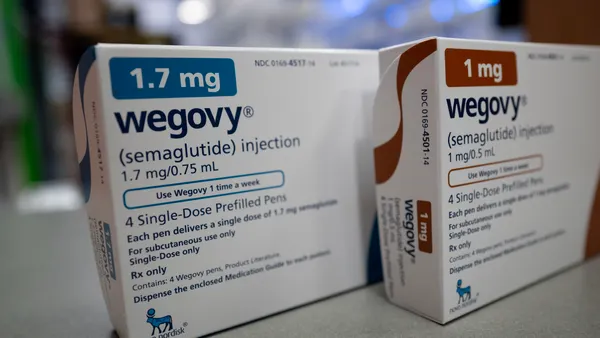Dive Bullets:
- Health insurers are steadily expanding their control over the U.S. primary care market — especially in areas with a lot of seniors eligible for Medicare Advantage plans, according to new research.
- In 2023, payer-operated practices accounted for 4.2% of the national Medicare primary care market by service volume, up from 0.8% in 2016, the study published in Health Affairs Scholar found. It’s the first concrete estimate of insurer ownership of physician practices nationwide, and suggests that vertical consolidation is being driven by the potential for profits in nudging MA members to owned clinics, researchers said.
- The paper could also intensify the microscope on UnitedHealth as lawmakers and regulators scrutinize the healthcare behemoth’s outsized control over the industry. UnitedHealth-owned Optum was the largest operator of primary care clinics of all the insurers included in the analysis, holding more than 2.7% of market share nationally and more than 35% in several large counties.
Dive Insight:
Health insurers have been steadily snapping up physician practices despite rising concerns from provider groups, patient advocates and some lawmakers.
Payers say that owning medical offices allows them to better coordinate care for their members, especially in value-based arrangements, improving outcomes and steering patients to lower-cost settings.
But critics are concerned that vertical integration may allow insurers to steer patients toward their own doctors at the expense of other practitioners, disadvantage rival insurers by shutting in-house providers out of their networks and allow other anticompetitive behavior, potentially leading to higher prices and less choice for patients.
Worries about vertical consolidation have snowballed over the last few years as major payers increased M&A to catch up with Optum, which kicked off the vertical integration trend more than one decade ago.
Last spring, then-UnitedHealth CEO Andrew Witty said that Optum has grown to employ “just under 10,000” doctors — roughly 1% of all physicians in the U.S. — and be affiliated with another 80,000.
But UnitedHealth’s peers, including Humana, Elevance and CVS’ Aetna, have also grown their reach though large-scale M&A, quiet acquisitions of standalone practices and organic expansion.
Of the more than 381,000 primary care doctors billing Medicare in 2023, 6.4% worked for a payer-operated practice, according to the new study from researchers with the nonprofit Brookings Institution and Cornell Medical College’s Health Policy Center.
Compared to hospitals, which own more than one-third of all doctor’s offices nationwide, that’s a relatively small share. But it could be a slight underestimate based on how researchers defined ownership, according to Loren Adler, the associate director of the Brookings Institution’s Center on Health Policy and author of the study.
And payers controlling more than 4.2% of the Medicare primary care market is still a “pretty healthy number” that’s “been growing pretty rapidly,” Adler said.
“If it just completely stopped now, it may only be so big of a story, but if it continues expanding as it’s been, I think it becomes a very large story,” he added. “The fact that it’s only 4% — it means the broad, systemwide effects are probably smaller than some people were thinking, at least so far. There’s only so much 4% of the market can do. But that being said, they are big in certain areas.”
Insurer control is significantly more concentrated in certain counties: Overall, more than 15% of the U.S. population lived in counties where payers owned more than 10% of the primary care market in 2023, the study found.
More than 10% lived in counties where Optum alone exceeded that threshold.
And there are pronounced outliers. In 2023, Optum controlled almost 45% of the primary care market in Snohomish County, Washington; more than 40% in Contra Costa County, California; and almost 36% in Clark County, Nevada, according to the research.
Notably, payers were significantly more likely to own primary care practices in areas where MA was more prevalent. Clinics owned by payers also delivered a substantially larger share of primary care services in MA as compared to traditional Medicare, the study found.
That suggests payers may be driven to purchase physician practices because of the chance to expand profits in the privatized Medicare plans, which tends to be more lucrative than other types of insurance, Adler said.
The calculus goes like this.
By increasing members’ access to primary care providers and heading off worse health outcomes (and higher medical costs) down the line, MA insurers can keep a greater share of premiums as profit. MA insurers can also lean on in-house doctors to diagnose their MA members with more conditions to inflate their reimbursement from the federal government, a much-maligned practice called upcoding.
The temptation to increase upcoding could be spurring insurers to expand their medical networks, according to Adler.
“A lot of this seems to be a Medicare Advantage story,” Adler said. “Certainly we already have a fair amount of evidence that vertically integrated payers tend to be able to code their enrollees more intensely and are able to make their enrollees look sicker ... and the way Medicare Advantage pays, you get paid more money the sicker your patients look.”
Rising evidence of upcoding has fueled calls for MA reform, especially as the program grows. MA has swelled to cover 33 million people, more than half of all seniors in Medicare coverage.
The growth has exacerbated concerns about Medicare’s fiscal integrity. Congressional advisory group MedPAC estimates that CMS will pay MA insurers $84 billion more this year than the government would have if those members had been in traditional Medicare. Upcoding was responsible for almost half of those overpayments.
Both the Biden and the Trump administrations have taken action to crack down on upcoding, while bipartisan members of Congress have expressed interest in pursuing legislation to prevent profiteering in the program. Republicans’ sweeping domestic policy bill was seen as a vehicle to potentially pass such reform, but the final version passed into law by President Donald Trump on July 4 included no curbs on bad behavior in MA.
Adler said it’s worthwhile for Congress to limit overpayments in MA, but that the complexity of the issue could continue to hamstring meaningful policymaking from Washington.
”We kind of know what [insurers are] taking advantage of. And to the extent that you can go after that, or even just sort of limit any overpayments, that at least takes away some of the low-hanging fruit here and probably right-sizes or sort of shrinks the desire to compile a ton of practices under an insurer’s umbrella,” Adler said. “There is a chance, given that there are some policies that both parties, most people, actually like. They’re just politically difficult.”















